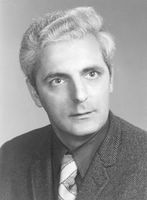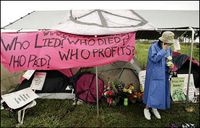By Hannah Allam
Knight Ridder Newspapers
BAGHDAD, Iraq - Iraqi investigators have uncovered widespread fraud and waste in more than $1 billion worth of weapons deals arranged by middlemen who reneged or took huge kickbacks on contracts to arm Iraq's fledgling military, according to a confidential report and interviews with U.S. and Iraqi officials.
The Iraqi Board of Supreme Audit, in a report reviewed by Knight Ridder, describes transactions suggesting that senior U.S.-appointed Iraqi officials in the Defense Ministry used three intermediary companies to hide the kickbacks they received from contracts involving unnecessary, overpriced or outdated equipment.
Knight Ridder reported last month that $300 million in defense funds had been lost. But the report indicates that the audit board uncovered a much larger scandal, with losses likely to exceed $500 million, that's roiling the ministry as it struggles to build up its armed forces.
Te episode deprives Iraq's military of essential gear that could help prepare the way for U.S. forces to withdraw. It also raises questions about the new government's ability to provide an effective defense against an entrenched insurgency and win broad acceptance among Iraqis.
The audit board's investigators looked at 89 contracts of the past year and discovered a pattern of deception and sloppiness that squandered more than half the Defense Ministry's annual budget aimed at standing up a self-sufficient force, according to a copy of the 33-page report.
Iraqi Defense Minister Saadoun al-Dulaimi confirmed most of audit board report's findings in an interview last Sunday, saying that at least $500 million in Iraqi money essentially has disappeared. He's removed nine senior officials so far - he fired the ministry's procurement chief and placed his own deputy minister, Bruska Shaways, on leave - and said he was working through a list of other employees who faced dismissal and possible criminal charges.
Among the findings:
-Multimillion-dollar contracts were awarded to favored weapons suppliers without a bidding process and without the required approval from the prime minister's office. Investigators wrote that the chief procurer went "beyond his authority" in purchasing equipment.
-Senior Iraqi officials kept little or no record of major purchases, sometimes noting lucrative deals in "undated and unnumbered" memos. Nearly all purchases contained a clause - unusual in international contracting of this magnitude - that required the contract's full value to be paid up front in cash.
-Instead of buying directly from a foreign company or government, Iraqi arms procurers hired third-party companies to negotiate the contracts. When Iraqi leaders later complained about unfulfilled contracts, they discovered they had no recourse to demand a refund because the payments were made to Iraqi middlemen who vanished after receiving the millions. "The undertakings make no obligation ... toward the Iraqi Ministry of Defense," according to the report.
-The sole beneficiary on 43 of the 89 contracts was a former currency-exchange operator, Nair Mohamed al-Jumaili, whose name doesn't even appear on the contracts. At least $759 million in Iraqi money was deposited into his personal account at a bank in Baghdad, according to the report. Internal records incorrectly "indicated that the Ministry of Defense signed contracts with Poland, Arab countries, the United States and Europe, but we discovered that all contracts were signed and executed with Iraqi suppliers," the report said.
The contracts under scrutiny total $1.27 billion, nearly equal to the estimated $1.3 billion allocated for the Defense Ministry's budget this year. The money came solely from Iraqi coffers, not from the training budget of the U.S. military or from NATO and foreign donations to Iraq's military.
"There's no rebuilding, no weapons, nothing," said retired Iraqi Lt. Gen. Abdul Aziz al-Yaseri, who worked in the Defense Ministry at the height of the alleged corruption. "There are no real contracts, even. They just signed papers and took the money."
Lt. Gen. David H. Petraeus, who oversees the U.S. military's training of Iraqi troops, conducts weekly briefings with the defense minister. Other Iraqi defense officials seldom are spotted without American civilian advisers nearby. The close relationship has raised questions as to how $500 million or more could vanish without U.S. intervention to stop the suspicious contracts that flowed for at least eight months.
"Ask them. I have the same question," al-Dulaimi said. "I blame those who posted them (the officials under investigation). And, by the way, the CPA posted them."
"Before me, there was another prime minister. His name was Bremer," Ayad Allawi, who served as interim premier when the corruption investigation began sometime last year, told Knight Ridder. "He ran this country, he had this ministry and a lot of the corruption started then. ... There was no auditing. Airplanes were flying in and the money was handed out in suitcases."
Former Defense Minister Hazem Shaalan has told U.S. and Iraqi officials that Bremer personally requested that Ziad Cattan - the alleged ringleader of the corruption and the ministry's former procurement chief - stay in his job after sovereignty was transferred last summer.
Even as hints of a corruption scandal emerged last spring, Cattan told others in the ministry that U.S. Defense Secretary Donald H. Rumsfeld personally had assured his job and no Iraqi had the power to remove him, al Dulaimi said. Instead of fleeing the investigation closing in on him, Cattan lobbied for even more authority. He wanted to become defense minister, a seat reserved for a Sunni Arab by al Jaafari's Shiite-dominated government, which was elected last January.
While many of the contracts did result in useful, if overpriced, equipment for Iraq's 80,000 new troops, contracts involving shoddily refurbished helicopters from Poland, crates of loose ammunition from Pakistan and a fleet of leak-prone armored personnel carriers were among purchases that now are deemed unnecessary or unusable.
With the money paid in advance and no mechanism for a refund, al-Dulaimi said, the Defense Ministry is negotiating with weapons dealers to substitute the equipment for more useful items such as guns, radio communications and other vital supplies.
"It's chaos," al-Dulaimi said, visibly exasperated. "It's a result of all the chaos brought to Iraq."



















